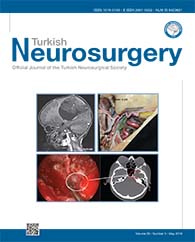2Koc University, School of Medicine, Department of Neurosurgery, Istanbul, Turkey DOI : 10.5137/1019-5149.JTN.24320-18.2 AIM: To evaluate the satisfaction of patients operated due to degenerative lumbar spinal diseases with dynamic stabilization placing polyetheretherketone (PEEK) rods and to share their radiological and clinical results (mid-term) with visual analogue scale (VAS) and Oswestry disability index (ODI) scores.
MATERIAL and METHODS: The preoperative and postoperative low back pain, leg pain VAS and ODI scores of 172 patients who were operated for degenerative spinal diseases, were evaluated. Preoperative and postoperative lumbar lordosis were compared. The patients included to the study were evaluated postoperatively around the 2nd year with lumbar MRI by means of adjacent segment disease (ASD) and additional problems.
RESULTS: A statistically but not radiologically-by means of sagittal profile reconstruction-significant increase in lumbar lordosis angle was achieved. Significant improvement was observed in the comparison of preoperative and postoperative period in the analysis of patientsâ preoperative low back pain (p<0.0001), and decompression-related leg pain VAS scores (p<0.0001). Significant improvement was also observed in the ODI scores of the patients (p<0.0001). Among 172 patients with dynamic stabilization, there were 10 patients who underwent reoperation (5.8%).
CONCLUSION: Although it is statistically significant, it can be seen that the lumbar lordosis can not be corrected at significant degrees radiographically in the operations performed with the PEEK rod. Dynamic stabilization with PEEK rod is insufficient for sagittal correction, but the mid-term results reached satisfactory reoperation rates clinically outcomes. Rate of ASD is quite low in stabilization with PEEK rod.
Keywords : Adjacent segment disease, Degenerative spinal disease, Dynamic stabilization, Lumbar lordosis, PEEK rod




